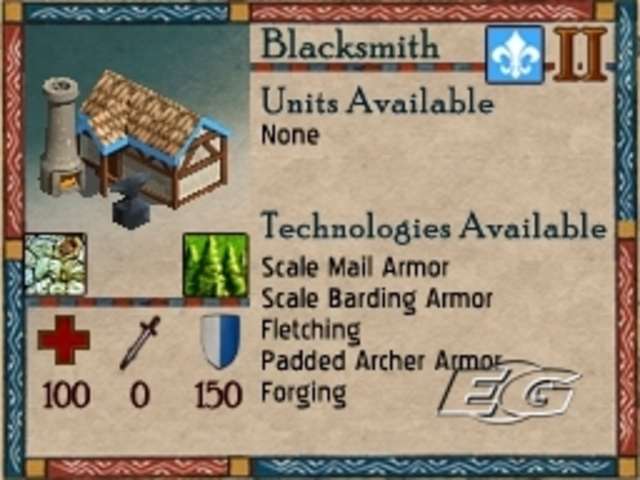Age of Empires: The Age of Kings
The art of shrinking thinking.
Money Money Money (And Wheat)
The non-military aspects of the game are rather perfunctory anyway, with the available resources reduced to just two - food and gold - both of which are required to build or train. Once you've established a few farms and goldmines, this side of the game pretty much takes care of itself, leaving your villagers to scramble around the map, avoiding death and finding places to construct the latest buildings. The same is true of research. Although they're presented in the Civ style, there's little subtlety to their implementation. They're really just fancy ways of boosting your stats - advanced mining techniques bring 10 per cent increases in gold output, inventing better shoes gives villagers an extra movement square per turn. As long as you prioritise the areas needed to advance your empire to the next age, progress isn't that hard. As you advance from the Dark Ages to the Imperial Age, new buildings open up to enable new unit types - stables train cavalry, barracks train soldiers and so on - with more sophisticated versions becoming available with each stage.
In keeping with the truncated maps, the timescale of the game has been accelerated as well. Regardless of size or complexity, training units, researching technologies or constructing buildings always takes just one day of game time. This simplifies things, but it does mean another avenue of strategy is lost. There's no need to keep the bottom rungs of your army supplied with grunts while working on the more lethal weaponry - you can just churn them all out overnight. This rapid turnover also makes it incredibly tough to topple an enemy town, as each turn spawns fresh troops to replace those you manage to vanquish. To balance this out, the game imposes a unit cap, so when you reach a certain number of units (including villagers) you have to wait for one to be defeated before you can train another. Injured units can be merged to reduce numbers, but while the technical reasons for this restriction are obvious it's still a frustrating barrier to place in your path.
The units are thoughtfully balanced against each other, though there is still an element of "rock, paper, scissors" evident in the way victory is dictated by using the right unit to attack with. Pikemen make mincemeat of those on horseback, but foot soldiers fall before cavalry. Terrain plays a part, and your ruler unit can also call upon special powers to boost the stats of nearby allies. Once you get into the rhythm of the game, there's a compelling ebb and flow to the battles that feels tangibly real, two forces pushing against each other on different fronts, rather than just a series of unrelated scraps. This is all fairly standard stuff in the PC series but to see all these elements interacting so convincingly on a handheld, even in an occasionally rudimentary form, is still quite an achievement.
Crowd Control

Graphically, the game opts for an isometric view on the bottom screen, with unit information and battle scenes played out on the top. These little skirmish animations are quite cute - and there's a genuine thrill to seeing your archers let fly with a satisfying "thwup, thwup, thwup" volley of arrows - but they can be skipped when you tire of them. It's on the bottom screen where the game's main visual flaw emerges. While the isometric view certainly makes for nicer screenshots, once the map fills up with units it becomes increasingly difficult to discern who is where and which is what.
It doesn't help that some units look very similar. Briton villagers and men-at-arms, for example, are nigh indistinguishable in the middle of a ruck. You end up relying on the right shoulder button to skip to each available unit, rather than trying to prod the right square with the stylus, and then checking the top screen to see who you've selected and what condition they're in. It's not an unworkable way of playing, but it is rather clumsy and could easily have been smoothed out with the simple inclusion of an optional top-down battlefield view.

None of these flaws are enough to diminish the achievement that Age of Empires represents on the DS, but they do serve to tarnish the overall experience a tad. Just when you're dazzled by how much has been crammed in, you bump into an invisible gameplay barrier that reminds you that for all its numerical might, it's not quite as big as you think, enough to make it sometimes feel more like a tantalising hint of things to come, rather than a leap forward in its own right. While there's still plenty to improve in a sequel, it sets an imposing benchmark for the next DS strategy title to measure up to.
You've probably noticed that I've studiously avoided mentioning Advance Wars so far. As the only other strategy game of note on the DS, it's obviously tempting to pit the two against each other, point for point, but there's no reason why strategy fans shouldn't enjoy both. Indeed, they almost certainly should. For all its ambition and scale, Age of Empires on the DS has a few too many shortcomings to make it the superior game in my eyes, but it definitely has the upper hand in some noteworthy areas. If nothing else, Age of Empires DS provides a title that will appeal to those Discovery Channel Dads who picked up the stylus for Brain Training, and proves that Nintendo's flip-top toy can supply grown-up depth as well as giddy frivolity. Now, if we can just get a DS version of Laser Squad Nemesis...








